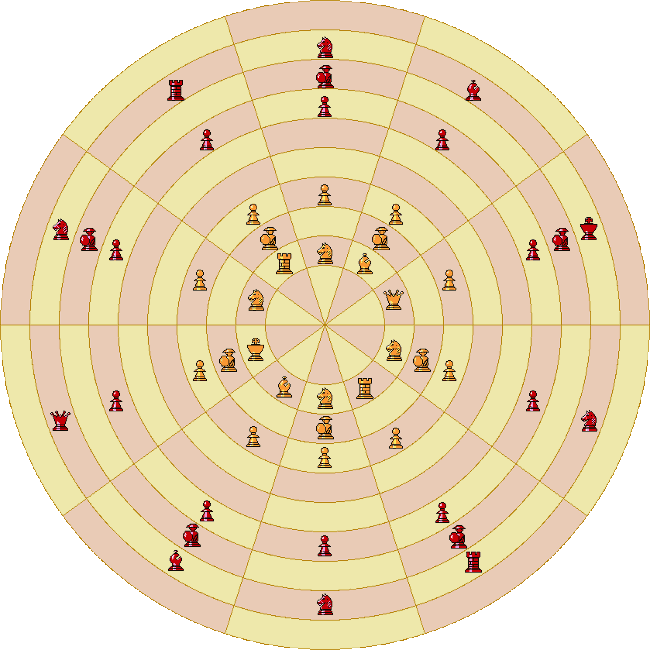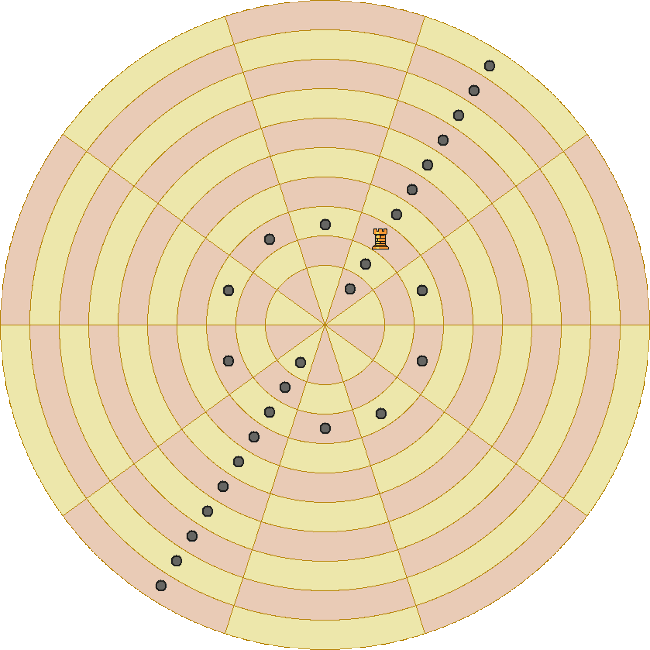Spherical Guard Chess
As mentioned in my previous variant that used a spherical board, the sphere may be completed in one of two ways:
- Use triangular cells at the poles
- Add a circular cell at the poles. These polar-cells may be 'dead', that is they are not part of the board; or may be 'live' and thus a part of the playing surface
Setup
The starting position is shown in Image 1.
| Image 1 |
|---|
 |
Pieces
The number of each piece per side at the start is:
- King: each side starts with 1
- Queen: each side starts with 1
- Knight: each side starts with 4
- Rook: each side starts with 2
- Bishop: each side starts with 2
- Guard: each side starts with 5
- Pawn: each side starts with 10
| Image 2 - Guard Movement | |
|---|---|
|
The Guard steps one or two cells in any direction in a straight line. A Guard
can thus reach a maximum of 16 cells. It may not jump over other pieces and may
not check the enemy King. Enemy pieces, except for Knights, must halt on
entering one of the 8 cells adjacent to a Guard. |

|
| Image 3 - Rook Movement | |
|
The Rook slides an unlimited number of cells orthogonally along either a great circle
that passes through the poles, or along a circle of latitude. It may not leap
other pieces and may not make a null move by returning to its starting cell.
|
 |
| Bishop Movement | |
| Image 4a | Image 4b |
 |

|
|
The Bishop slides an unlimited number of cells diagonally. It may not leap
other pieces and may not make a null move by returning to its starting cell.
Images 4a and 4b above illustrate the bishop's move. The diagonally connected pole
cells are indicated by the coloured spots.
|
|
The King, Queen (moves as either Bishop or Rook), Knight and Pawn move as in FIDE chess; though there is no castling nor initial double move for the Pawns (and thus no en-passent capture). When a Pawn reaches the opposite pole it promotes to a Queen
Rules
The two sides are Gold and Red. Gold moves first.
The aim is to checkmate, stalemate or bare the enemy King.
Notes
- Why the extra pieces?
- I feel 40 pieces in total on an edgeless board of 100 cells is rather sparse. So I determined to have a density of 50% as with FIDE chess; that is 25 pieces a side.
- What are the piece values?
- The movement arresting power of the Guard renders it immune to the
long-range attacks from Queen, Rook or Bishop. It's major drawback is its
inability to threaten the enemy King, and the Knight remains a threat.
The Bishop, though still colourbound, can reach more cells than the Rook (a maximum of 32 for the Bishop compared to the Rook's 27)
My implementation of this variant in Zillions gives these approximate values: Pawn 20; Knight 114; Guard 188; Rook 383; Bishop 398; Queen 749. - A better board?
- An alternative flat representation of a spheriacal board is derived by
splitting the sphere into 2 hemi-spheres. Image 5 shows the starting position
on this board, while Image 6 shows the co-ordinate system for such a board.
| Image 5 | Image 6 |
 |

|
 This 'user submitted' page is a collaboration between the posting user and the Chess Variant Pages. Registered contributors to the Chess Variant Pages have the ability to post their own works, subject to review and editing by the Chess Variant Pages Editorial Staff.
This 'user submitted' page is a collaboration between the posting user and the Chess Variant Pages. Registered contributors to the Chess Variant Pages have the ability to post their own works, subject to review and editing by the Chess Variant Pages Editorial Staff.
By Graeme C Neatham.
Web page created: 2010-03-19. Web page last updated: 2010-03-19
